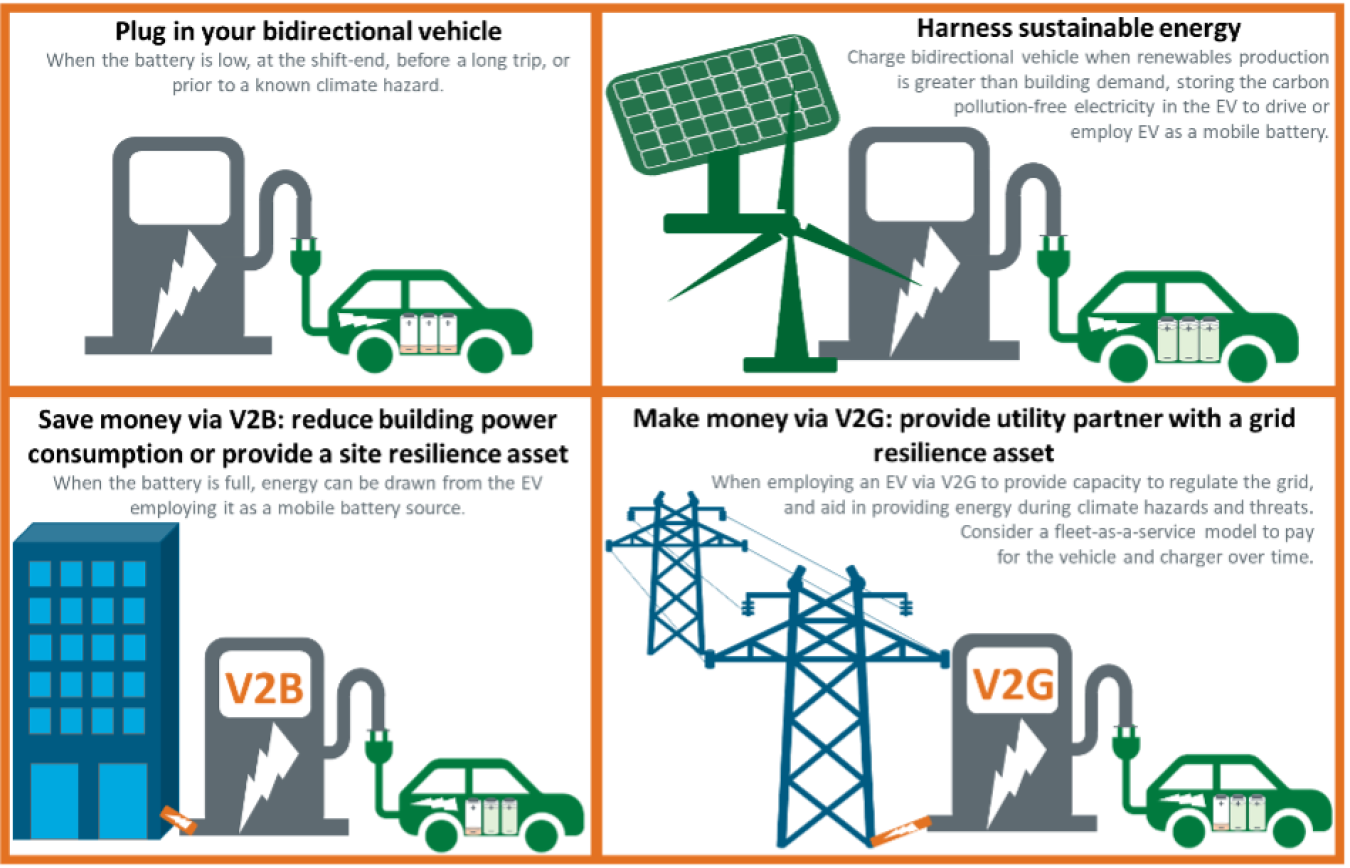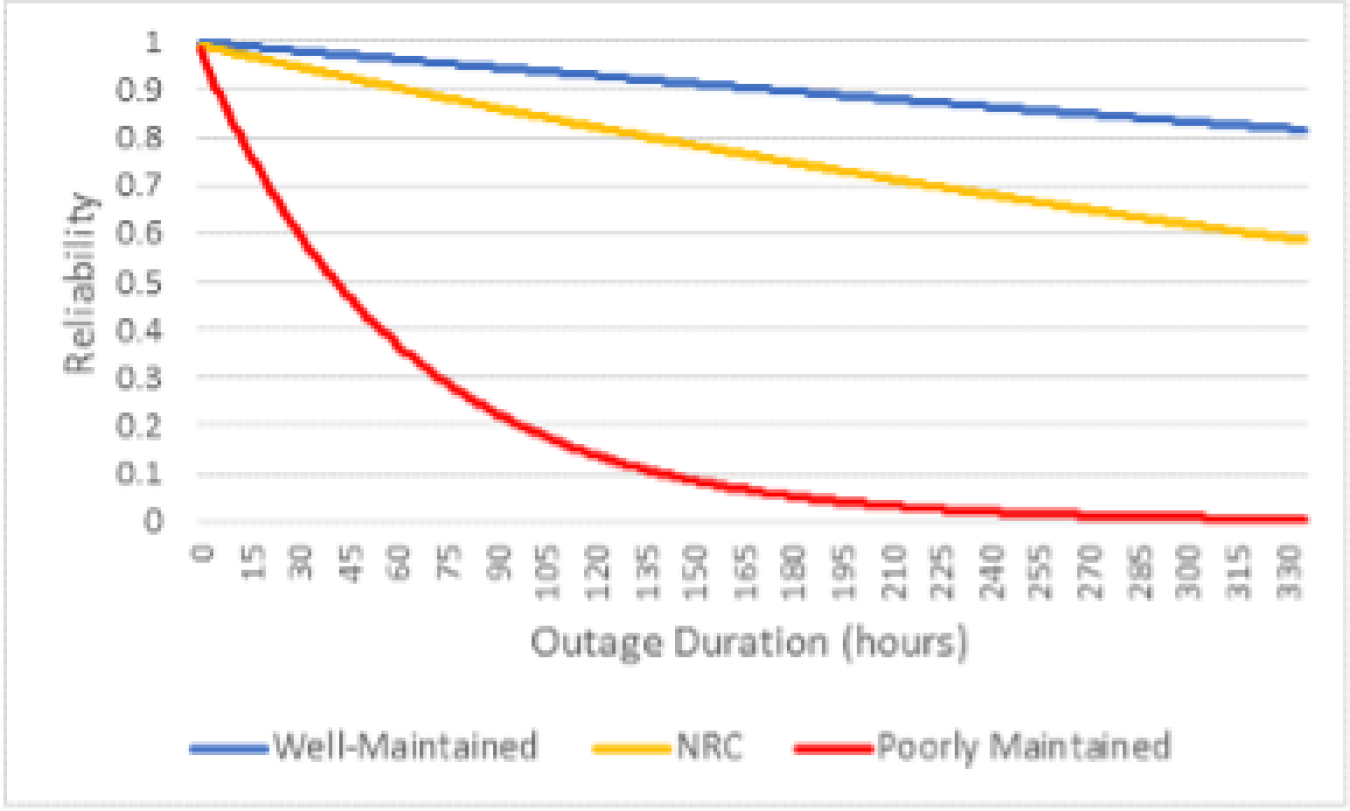Bidirectional electric vehicles (EV) employed as mobile battery storage can add resilience benefits and demand-response capabilities to a site’s building infrastructure. A bidirectional EV can receive energy (charge) from electric vehicle supply equipment (EVSE) and provide energy to an external load (discharge) when it is paired with a similarly capable EVSE.
Bidirectional vehicles can provide backup power to buildings or specific loads, sometimes as part of a microgrid, through vehicle to building (V2B) charging, or provide power to the grid through vehicle to grid (V2G) charging. V2B and V2G power solutions can complement solar photovoltaic (PV) arrays and other distributed energy resources (DERs), or supplement diesel generators as backup power. In contrast to stationary storage and generation which must stay at a selected site, bidirectional EVs employed as mobile storage can be mobilized to a site prior to planned outages or arrive shortly after an unexpected power outage to supplement local generation or serve as an emergency reserve.
The size of a light-duty EV battery (approximately 15–100 kWh) makes individual bidirectional units ideal for smaller applications like individual buildings, where they can optimize the use of PV and replace or supplement emergency diesel generators. Larger bidirectional EV fleets can be employed for larger applications.
Equipment costs and needs vary based on site location, size, design, and more. When planning EV infrastructure, sites may consider the current capabilities as some infrastructure may already be available, such as an inverter present due to existing solar PV or a transfer switch present due to an on-site emergency diesel generator.
Bidirectional EVs for Resilience
Mobile batteries can increase a facility's resilience posture while decarbonizing emergency generation. Depending on the specific situation, this use of EVs for mobile storage can conserve the amount of energy that a site uses from the grid or aid in reaching carbon emission targets by maximizing the consumption of local and sustainable power generation. In addition, regional fleets can be deployed to specific locations with the highest need in emergency scenarios, giving EVs an advantage over stationary batteries.
Bidirectional EVs for Demand Response
When planned according to the energy needs of the fleet and the site, bidirectional EV fleets can participate in demand response or time of use (TOU) arbitrage. Some utilities provide grid service programs where devices such as EVSE can be curtailed during peak loads on the grid to reduce the burden on grid infrastructure and reduce energy costs. These grid service markets include frequency regulation to provide short-term balancing of demand and supply. These benefits are also provided through TOU rates, which are typically designed with on- and off-peak rates. EVSE capable of shifting EV charging to occur during the lower-cost off-peak rates can decrease the cost of electricity for the fleet. Participating in grid services such as these can save the facility money and aid in reducing brownouts throughout a utility's service area during peak loads.

Coordinating with Your Utility
Agencies should communicate with their serving electric utility early in the electrification and planning process, and often throughout the process to ensure costs are minimized by understanding the rate structure, demand response, and incentives available to the site. Communicating with utilities prior to adding EVSE will aid the site in ensuring that the proper savings are accrued by harmonizing the increased electricity load of the site with the grid needs and availability. Installation requires planning by both the utility and fleet operator in advance. For some organizations this may require restructuring the timelines of internal business processes. Review FEMP's list of Utility Partnership Program utility partners.

Vehicle to Building Charging
Some V2B applications could decrease the cost of grid electricity through TOU arbitrage or increase the value of local generation by consuming all energy produced on-site, or avoiding PV curtailment. Many applications focus on resiliency efforts. Site resilience typically employs the use of a microgrid or backup generation to support building loads in the event of an outage. Some V2B options can provide features that may power a building on their own. However, most V2B options are best suited to increase the capabilities of an existing backup power solution. Conventional backup generators do not always function during grid power loss, especially if they are not well-maintained (Marqusee and Jenket, 2020). Because of high failure rates for emergency diesel generators, DERs and stationary storage have become more prevalent as resilience strategies. Bidirectional charging unlocks resilience benefits of EV batteries, offers demand-response capabilities, and can provide backup power.
Vehicle to Grid Charging
Through V2G, bidirectional charging could be used for demand cost reduction and/or participation in utility demand response programs as part of a grid-efficient interactive building (GEB) strategy. The V2G model employs the bidirectional EV battery, when it is not in use for its primary mission, to participate in demand management as a demand-side resource. Some utilities may provide a monetary incentive to a site for demand management or load reduction capabilities of their zero emission vehicle fleet. Third parties are often interested in developing this arrangement and sometimes provide both the EV and the bidirectional charger through a fleet-as-a-service contract. By being prepared to act as a mobile battery to charge/discharge as a demand response asset, the battery electric vehicles (BEVs) generate revenue which aids in justifying the capital costs of the BEVs and the associated support infrastructure.
Examples of EV Mobile Storage Used for V2G Market Participation
An example of the benefits of bidirectional EVs have been shown by the University of Delaware's (UD's) partnership with local electric utilities and with PJM, a regional transmission organization (RTO). UD is a registered market participant and demonstrated the first grid revenue generated from V2G. The terms of the partnership are that the university shall have their vehicles plugged in and available when called upon for grid support, and PJM pays the university the market rate for this service, which has been roughly $1,200 per year per BEV available. The storage is provided through a combination of fleet vehicles and stationary batteries with Nuvve Corp as the aggregator. Thus, in addition to functioning as vehicles for their primary mission (driving) these BEVs provide a resilience asset to the grid and monetary compensation to the fleet owner. More information can be found at https://crew.udel.edu/v2g/.
In December 2020, five BEV buses provided by Lion Electric to the White Plains, New York, school district began providing power to Con Edison customers. This was New York's first instance of buses feeding power to a utility grid. Another example of a mobile storage pilot is set to begin in Brooklyn, New York, in 2022. Under this partnership between Revel, NineDot Energy, and Fermata Energy, Revel's Brooklyn maintenance facility will test three Nissan Leaf BEVs and three of Fermata's bidirectional DC chargers, resulting in 45 kW of on-demand power from the BEVs flowing to Con Edison.
Outside of the United States, other countries are testing V2G capabilities as well. In Denmark, Nissan, Enel, and Nuvve are working with Denmark's utility, Frederiksberg Forsyning, to prepare for large commercial V2G systems in the country and the world's first commercial V2G hub. This agreement uses the vehicles in the program to stabilize the national electric grid by enabling the grid operator to charge or discharge the plugged-in vehicles on demand. The total capacity made available with this project at the utility's headquarters in Copenhagen is approximately 100 kW, and Nissan gives full warranty on the battery for the vehicles used in the project.

